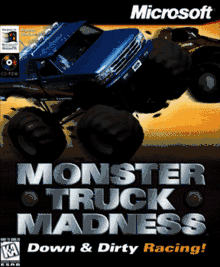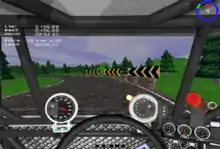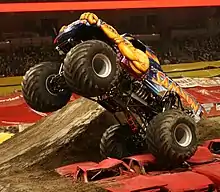Monster Truck Madness
Monster Truck Madness is a racing video game developed by Terminal Reality and published by Microsoft, released in North America on August 31, 1996. The game has twelve monster trucks and tasks the player with beating computer opponents. Checkpoints, multiple hidden shortcuts, and interactable objects commonly appear in the tracks. In the garage, the player modifies the truck to account for terrain surfaces. Online multiplayer is accessed with a modem, a local area network (LAN), or TCP/IP.
| Monster Truck Madness | |
|---|---|
 | |
| Developer(s) | Terminal Reality |
| Publisher(s) | Microsoft |
| Designer(s) |
|
| Programmer(s) |
|
| Artist(s) |
|
| Composer(s) |
|
| Series | Monster Truck Madness |
| Engine | Photex |
| Platform(s) | Microsoft Windows |
| Release |
|
| Genre(s) | Racing |
| Mode(s) | Single-player, multiplayer |
Terminal Reality designed Monster Truck Madness to accurately simulate monster truck events and replicate the titular off-road vehicles. The developer hired announcer Armey Armstrong to perform sports commentary. The game received a massive following, and video game publications generally praised its gameplay, graphics, and physics. It is the first entry in Microsoft's Madness series of racing titles, which included Motocross Madness and Midtown Madness. Monster Truck Madness was followed by a sequel, Monster Truck Madness 2. Terminal Reality developed another off-road truck racing game, 4x4 Evo.
Gameplay

Monster Truck Madness offers twelve monster trucks, including Bigfoot, Grave Digger and Snake Bite,[lower-alpha 1] and tasks the player with beating computer opponents in four single-player modes: Drag, Circuit, Rally, and Tournament.[2][3] Drag focuses on traditional monster truck events set in arena and stadium venues[4][5] like BC Place[1]:BC Place description and Tacoma Dome;[1]:Tacoma Dome description the player qualifies to participate in knockout races that involve jumping over rows of cars.[4][5] Circuit has five short race tracks, and Rally has long exotic tracks[4][5] themed after Arizona,[1]:Arizona description the highlands,[1]:Highlands Rally description and the Yucatán.[1]:Yucatan Adventure description In Tournament, the player participates in a custom series of events with computer opponents.[1]:Tournament menu Checkpoints,[6] multiple hidden shortcuts (like a broken bridge),[3] and interactable objects (such as cactuses, road signs, and fences) commonly appear in the tracks.[4][7] The finder directs the truck towards the checkpoint. The player can call the helicopter to put the truck back on the road.[3]
In the garage, the player modifies the truck's tires, suspension, and acceleration-to-speed ratio to account for terrain surfaces such as mud and grass. The player can compete in multiplayer using DirectPlay and with a modem, LAN, or TCP/IP.[2][3] The game includes multiple camera angles like blimp and cockpit, as well as the ability to watch and save replays of the events.[2][8]
Development and release

American video game studio Terminal Reality, Inc. designed Monster Truck Madness to accurately simulate monster truck events such as drag tracks and enclosed circuit races, and replicate the titular off-road vehicles on land, when jumping, and during collisions. Sound effects of the trucks were recorded and digitized from such races. The game's twelve monster trucks were used under license from companies like Bigfoot 4×4, Inc., the owner of Bigfoot and Snake Bite. The developer hired announcer Armey Armstrong[lower-alpha 2] to perform sports commentary, resulting in lines such as "Bigfoot is doing it in the air!" and "when it's going your way, it's going your way."[2][8]
On May 16, the game was displayed at the Electronic Entertainment Expo (E3), and Microsoft announced its autumn release date.[2] It was released in North America on August 31.[9] Monster Truck Madness was one of the first titles to provide force feedback and Direct3D support and required a video card for smooth, quickly processed graphics.[3][10] It even included an online manual and full motion videos (FMVs) of monster truck events.[5]
Reception
Sales
Monster Truck Madness was a commercial success, accumulating a massive worldwide following.[11] The game peaked at number 10 at PC Data's PC games sales charts during October, subsequently dropping to number 18 for November.[12] It debuted at number 73 at NPD Group's Top Entertainment Titles chart in September, reaching number 13 in October.[13]
Critical reviews
| Aggregator | Score |
|---|---|
| GameRankings | 77%[14] |
| Publication | Score |
|---|---|
| CGW | Positive[7] |
| GameSpot | 7.4/10[6] |
| Next Generation | |
| PC Gamer (US) | 85/100[3] |
| PC Zone | 78%[15] |
| Game Briefs | Positive[11] |
| Game Revolution | B+[4] |
| PC Games | B-[5] |
— Jason C. Carnevale of Game Revolution on the graphics of Monster Truck Madness.[4]
Monster Truck Madness received mainly positive reviews from printed and online video game publications. Praise was given by Jeff Lundrigan, a review editor for Next Generation, who stated it exploits the capabilities of Windows 95, since it can achieve high frame rates without 3D graphics accelerator cards. He was entertained by the game's physics model but saw it as unrealistic, citing an example of a monster truck jumping almost 100 feet above a hill.[10] While GameSpot's Rebecca Anderson perceived monster truck racing as immature, she enjoyed playing the game and praised Armstrong's commentary. However, she spotted visual glitches appearing near static objects.[6] The game's official website quoted a review from Bernard Dy of the website Game Briefs; Dy accoladed it as one of the greatest Windows 95 games, viewing its graphics as similar to Papyrus Design's NASCAR Racing and saying the physics were "designed for fun". Although he cautioned that players expecting realism would be disappointed at the lack of a printed manual and an absent damage model, he opinioned its sound design and online manual benefit the game.[11] All three writers considered the significant number of customizable performance variables to befit all "skill level[s]".[6][10][11] PC Zone likened the game to a hybrid of Stunt Car Racer and NASCAR Racing.[15]
Writing for Computer Gaming World, M. Clarkson commented that the game puts an emphasis on simplicity over detail, and added that players would be amused over jumping in the air and traversing the mud.[7] Jason C. Carnevale of Game Revolution was surprised at its graphical quality, saying driving through the circuits is visually pleasant with billboards, stands, automobiles, barbeque pits, and Winnebagos. He viewed the controls as comfortable and appreciated the game's multiple shortcuts. Carnevale recommended Monster Truck Madness for players desiring a short game of excitement.[4] Reviewing the game for PC Gamer, Colin Williamson was enthused over the design of the trucks and enjoyed its gameplay, but criticized Armstrong and felt a higher number of tracks would be satisfactory. He said the tracks are sizeable and diverse and favored the Rally races for their openness. Williamson stated that Microsoft minimized the realism to lessen the game's difficulty.[3] Rob Smith of PC Games commented about the trucks' slowness and noticed that their big tires allow them to bounce when "stray[ing] from the beaten track". According to Smith, auto-shift and auto-braking "on corners" assist players well. He was impressed that up to eight players can participate in the game's online multiplayer mode. Smith summarized that the game lacked originality, but provided a solid arcade-style racing experience.[5] Monster Truck Madness was nominated for Computer Games Strategy Plus' 1996 Racing Simulation of the Year award, but lost to NASCAR Racing 2.[16]
Legacy
Monster Truck Madness is the first entry in the Madness series of racing titles distributed by Microsoft.[17] Terminal Reality developed the game's 1998 sequel, Monster Truck Madness 2; it features more trucks and tracks and uses the Photex2 game engine for improved graphics and physics.[18][19] Microsoft subsequently published the motorcross-centered Motocross Madness in 1998,[20] and the open world Chicago-themed Midtown Madness in 1999,[21] both of which also received sequels.[22][23][24] In collaboration with Microsoft, THQ and Tantalus Media created a 2003 Game Boy Advance game dubbed Monster Truck Madness, sporting 2.5D graphics, powerups, and time trial mode.[25] GameSpot named it the best Game Boy Advance game of August 2003.[26]
Terminal Reality developed another off-road truck racing game, 4x4 Evo. In its Career Mode, the player participates in races to earn money for purchasing trucks.[27] Its sequel 4x4 EVO 2 introduced Adventure Mission mode, where the player performs treasure hunts and rescue operations to obtain additional money.[28]
Notes and references
Footnotes
- The other monster trucks are Bear Foot, Boogey Van, Carolina Crusher, Monster Patrol, Overkill, Power Wheels, Rampage, Samson, and Wildfoot.[1]:Races menu (Pick A Truck)
- Armey Armstrong is listed as "Army Armstrong" in the credits.[1]:Credits
Citations
- Terminal Reality (August 31, 1996). Monster Truck Madness (Microsoft Windows). Microsoft.
- "Microsoft Monster Truck Madness Crushes and Leaps Its Way Into Electronic Entertainment Expo (E3)". Microsoft. Microsoft. May 16, 1996. Archived from the original on February 16, 2020. Retrieved February 16, 2020.
- Williamson, Colin (December 1996). "Microsoft Monster Truck Madness". PC Gamer. Imagine Media. Archived from the original on February 29, 2000. Retrieved February 25, 2020.
- Carnevale, Jason C. (1996). "Monster Truck Madness Review". Game Revolution. Net Revolution, Inc. Archived from the original on April 17, 2004. Retrieved February 24, 2020.
- Smith, Rob (December 1996). "Monster Truck Madness". PC Games. International Data Group (IDG). Archived from the original on February 7, 1997. Retrieved February 25, 2020.
- Anderson, Rebecca (September 26, 1996). "Monster Truck Madness (1996) Review". GameSpot. CBS Interactive. Archived from the original on June 28, 2019. Retrieved 15 January 2018.
- Clarkson, M. (December 1996). "On the Shelf: Monster Truck Madness". Computer Gaming World. No. 149. Ziff Davis. p. 43.
- Anderson, Rebecca (May 1, 1996). "Monster Truck Madness Preview". GameSpot. CBS Interactive. Archived from the original on February 16, 2020. Retrieved February 16, 2020.
- "Monster Truck Madness (1996)". GameSpot. CBS Interactive. August 31, 1996. Archived from the original on May 9, 2012. Retrieved February 21, 2020.
- Lundrigan, Jeff (February 1997). "Finals: Monster Truck Madness". Next Generation. No. 26. Imagine Media. p. 130.
- "Terminal Reality Web Site: Monster Truck Madness". Terminal Reality. Terminal Reality. 1997. Archived from the original on February 4, 1998. Retrieved February 25, 2020.
- GamerX (January 10, 1997). "November's 30 best-sellers". CNET GAMECENTER. PC Data. Archived from the original on February 5, 1997. Retrieved March 16, 2020.
- "Industry Expertise - PC Software - October 1996". NPD. NPD Group. November 1996. Archived from the original on February 25, 1999. Retrieved March 16, 2020.
- "Monster Truck Madness Reviews". GameRankings. CBS Interactive. 2009. Archived from the original on December 6, 2009. Retrieved February 20, 2020.
- "Buyer's Guide: Monster Truck Madness". PC Zone. No. 45. Future plc. December 1996. p. 178.
- "Computer Games Strategy Plus announces 1996 Awards". Computer Games Strategy Plus. Chips & Bits. March 25, 1997. Archived from the original on June 14, 1997. Retrieved November 2, 2010.
- Dunkin, Alan (April 22, 1999). "Midtown Madness Goes Gold". GameSpot. CBS Interactive. Archived from the original on May 8, 1999. Retrieved April 9, 2020.
- Lundrigan, Jeff (August 1998). "Finals: Monster Truck Madness 2". Next Generation. No. 44. Imagine Media. p. 102.
- "Monster Truck Madness 2". Microsoft. Microsoft. Archived from the original on August 16, 2000. Retrieved April 8, 2020.
- Peters, Terry. "Motocross Madness - Review". AllGame. All Media Network. Archived from the original on November 15, 2014. Retrieved February 24, 2020.
- Couper, Chris. "Midtown Madness - Review". AllGame. All Media Network. Archived from the original on November 15, 2014. Retrieved November 23, 2014.
- Kanarick, Mark. "Motocross Madness 2 - Review". AllGame. All Media Network. Archived from the original on November 15, 2014. Retrieved March 17, 2015.
- Couper, Chris. "Midtown Madness 2 - Review". AllGame. All Media Network. Archived from the original on November 15, 2014. Retrieved November 23, 2014.
- "Midtown Madness 3". Electronic Gaming Monthly. No. 170. August 2003. p. 119. Archived from the original on 10 March 2004. Retrieved 9 September 2014.
- Harris, Craig (August 19, 2003). "Monster Truck Madness". IGN. Ziff Davis. Archived from the original on August 26, 2014. Retrieved July 18, 2015.
- The Editors of GameSpot (August 28, 2003). "GameSpot's Month in Review: August 2003". GameSpot. Archived from the original on March 1, 2004.
- Bramwell, Tom (November 15, 2000). "4x4 Evolution (PC)". Eurogamer. Gamer Network. Archived from the original on March 3, 2016. Retrieved January 6, 2015.
- Mahood, Andy (March 2002). "4x4 Evo 2". PC Gamer. Imagine Media. Archived from the original on March 15, 2006. Retrieved January 7, 2015.
External links
- Official website at the Wayback Machine (archived February 4, 1998)
- Monster Truck Madness at MobyGames